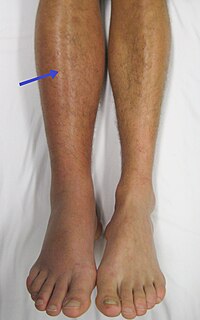
Photo from wikipedia
BACKGROUND Venous thromboembolic events (VTEs) frequently occur in cancer patients. Risk assessment models (RAMs) for cancer-associated thrombosis have been proposed. However, advanced urinary tract cancer (aUTC) was not adequately represented… Click to show full abstract
BACKGROUND Venous thromboembolic events (VTEs) frequently occur in cancer patients. Risk assessment models (RAMs) for cancer-associated thrombosis have been proposed. However, advanced urinary tract cancer (aUTC) was not adequately represented in these models. We studied the incidence of VTEs, the risk factors, and the applicability of recently described RAMs. PATIENTS AND METHODS Data from 335 patients with aUTC treated with chemotherapy between April 1995 and September 2015 in a single institution were analyzed. RESULTS A total of 95.2% received platinum-based first-line chemotherapy. Twenty-nine patients (8.7%) experienced VTEs. The 6-, 12-, and 24-month VTE incidence was 7.4% (95% confidence interval [CI], 4.8-10.6), 8.1% (95% CI, 5.4-11.5) and 9.4% (95% CI, 6.4-13.1), respectively. No significant association of VTE incidence with the Khorana risk score was observed. History of vascular event (VTE and/or arterial thromboembolic event) was significantly associated with the development of VTE. Patients with such history had a 6-, 12-, and 24-month VTE incidence of 16.2% (95% CI, 6.6-29.7), 19.2% (95% CI, 8.4-33.3), and 25.2% (95% CI, 12.5-40.1) compared to 6.2% (95% CI, 3.7-9.4), 6.6% (95% CI, 4.1-10), and 7.1% (95% CI, 4.4-10.6) of those who did not. The discriminatory ability of this factor adjusted for leucocyte count, sex, Eastern Cooperative Oncology Group performance status, and type of chemotherapy reached 0.79 (95% CI, 0.71-0.87) compared to the 0.58 (95% CI, 0.49-0.66) for the Khorana risk score. CONCLUSION Development of tumor-specific algorithms for the risk of VTEs is advisable. Patients with aUTC and a history of vascular events are at high risk for VTE development, and prophylaxis should be prospectively studied in this group.
Journal Title: Clinical genitourinary cancer
Year Published: 2020
Link to full text (if available)
Share on Social Media: Sign Up to like & get
recommendations!